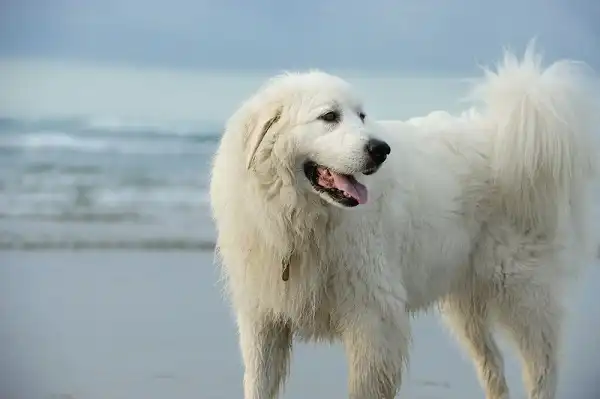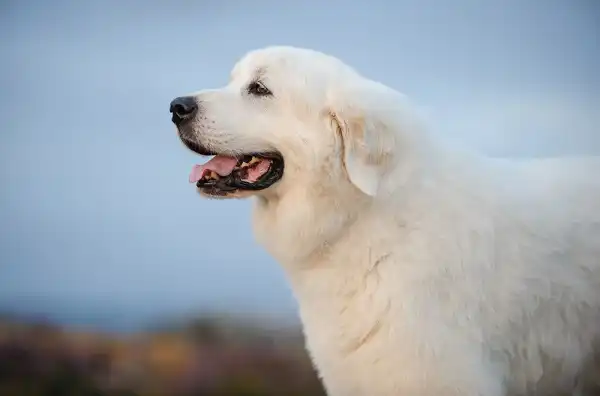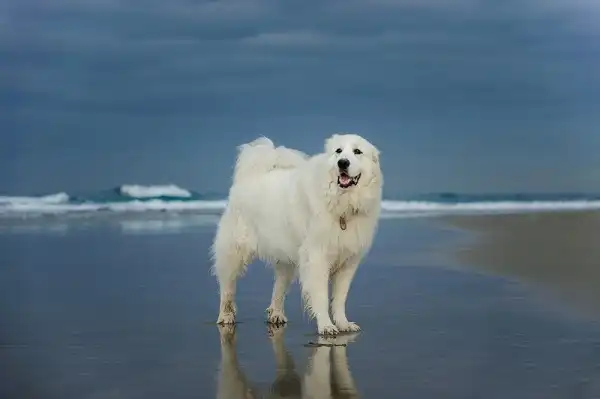Dogs come in many shapes and sizes, but few breeds tote quite the nobility of the Great Pyrenees. These large fluffy giants were historically bred as guardians of livestock and property, with their beautiful white coats and unflinching loyalty serving them well in this role throughout history. Not only do they make excellent guard dogs, but they can also be great companions – making them a perfect choice for those looking for canine protection that comes with an enjoyable and loving personality. In this blog post, we’ll take a closer look at everything from the breed’s origins to its care requirements so you can decide if this dog is right for your home!

Great Pyrenees Description
The Great Pyrenees are known for their stunning appearance, with thick, white fur and majestic stature. These dogs have a rich history dating back to the Pyrenees Mountains, where they provided protection for sheep and other livestock. Today, they are still valued for their guarding instincts and loyalty to their families. Despite their size, Great Pyrenees are gentle giants and make wonderful family pets. They are calm and patient with children and have a natural protectiveness that makes them excellent for households with multiple pets. However, because of their guarding instincts and size, they do require proper socialization and training from an early age.
Great Pyrenees Habitat
The Great Pyrenees is a dog breed that has a rich history and is well-known for its stunning appearance. These majestic dogs were originally bred in the Pyrenees Mountains, where they served as guardians of livestock and property. Today, they are still valued for their natural guarding instincts and loyalty to their families. In terms of their habitat, the Great Pyrenees requires a large space to move around and exercise in. They are not well-suited to apartment living and thrive best in a home with a spacious yard. It is essential to provide these dogs with a secure and enclosed outdoor area, as they have a tendency to roam and may wander off if left unattended. Their thick white fur is another important aspect of their habitat. Great Pyrenees require regular grooming to prevent matting and to keep their coat healthy and shiny. Their fur acts as insulation, keeping them warm during colder weather but also making them more prone to overheating during hot summer days. It is important to provide them with a shaded area to rest, access to plenty of clean water, and adequate ventilation to keep them cool.
Great Pyrenees Diet
Great Pyrenees are large and majestic dogs that require a balanced and nutritious diet to maintain their health and vitality. As with all dog breeds, it is important to feed them a diet that is appropriate for their age, weight, and activity level. Protein is an essential component of a Great Pyrenees’ diet as it helps build and repair muscle tissue. They require high-quality protein from sources such as chicken, beef, and fish. In addition, their diet should include carbohydrates, such as rice or oats, to provide energy for exercise and play. Great Pyrenees are prone to weight gain, so it is important to monitor their food intake and provide them with regular exercise. out all day can lead to overeating and obesity, which can have a negative impact on their joint health and overall well-being.
When choosing a commercial dog food, it is important to select a high-quality brand that meets their nutritional needs. Look for brands that list whole meats as the first ingredient, and avoid those that contain fillers and artificial preservatives. In addition to their regular meals, Great Pyrenees also benefit from occasional fruits and vegetables as treats or supplements. Carrots, green beans, and sweet potatoes are great sources of fiber and vitamins for dogs. However, it is important to avoid giving them foods that are toxic to dogs such as grapes, chocolate, and avocado.

Great Pyrenees Size
When it comes to size, the Great Pyrenees is known for being a large and powerful dog. Adult males typically stand between 27-32 inches tall at the shoulder and can weigh up to 100-120 pounds, while females usually measure between 25-29 inches in height and can weigh between 85-110 pounds. Their massive size and muscular build make them formidable protectors, which is one reason why they were historically bred to guard flocks of sheep in the Pyrenees mountains. They have a double coat that is thick and dense, with a soft undercoat that provides insulation against the cold. Their outer coat is long and either straight or slightly wavy, and often has a white or cream-colored base with patches of tan, gray, or reddish-brown.
Great Pyrenees Lifespan
The Great Pyrenees is a majestic and robust breed of dog that has an average lifespan of 10 to 12 years. It is not uncommon for them to live longer, especially if they are well cared for and receive proper nutrition and exercise throughout their life. While this breed is generally healthy, there are a few health issues that are more common in Great Pyrenees dogs that can impact their lifespan. One of the most significant health concerns is hip dysplasia, a condition that results from an abnormal formation of the hip joint, which can lead to arthritis and lameness. Great Pyrenees dogs may also be prone to bloat, a condition where the stomach fills with gas and rotates, which can cause a life-threatening emergency. To ensure that your Great Pyrenees lives a long and healthy life, it is essential to provide them with a balanced diet that meets their nutritional needs, as well as regular exercise and veterinary care. As they age, it is even more important to prevent obesity and address any health concerns as soon as they arise.
Great Pyrenees Behavior
Great Pyrenees dogs are known for their gentle and calm disposition, which makes them a popular choice for families with children. They are loyal and affectionate towards their owners but can be wary of strangers. Early socialization is crucial for this breed, as it helps them develop confidence and social skills. Traditionally bred to guard flocks of sheep in the Pyrenees mountains, Great Pyrenees are natural protectors. They have a strong instinct to guard their family and territory, often without any training. However, this protective instinct may also manifest as aggression towards strangers or other dogs if not properly socialized and trained. Therefore, owners of this breed should prioritize socialization and obedience training from an early age. Great Pyrenees are intelligent dogs and can sometimes exhibit stubborn behavior.
They require a firm but gentle approach to training, with plenty of positive reinforcement. Harsh training methods can be counterproductive and may lead to fear or anxiety. While they are moderate to low-energy dogs, Great Pyrenees still enjoy regular exercise and mental stimulation. They are content with a daily walk or playtime in a fenced yard but also enjoy hiking or other outdoor activities with their owners. One thing to keep in mind is that Great Pyrenees shed a lot, especially during their seasonal shedding periods.

Great Pyrenees Speed
Great Pyrenees are not typically known for their speed, as they are a large breed with a moderate to low energy level. However, they are capable of running at a decent speed when they want to, and they possess impressive stamina. On average, Great Pyrenees dogs can reach a top speed of around 25 miles per hour. While this may not be as fast as some other breeds, it is still impressive considering their size and build. Their powerful legs and muscular body enable them to run with agility and grace, even over rugged terrain. This is due in part to their heritage as working dogs in the Pyrenees Mountains, where they were bred to traverse challenging landscapes and protect their flocks.
Great Pyrenees Hunting
The Greatrenees, while not typically known for their hunting prowess, have a long history of working as livestock guardians and protectors. As such, they possess many of the skills necessary for hunting, including a keen sense of smell, excellent eyesight, and impressive physical strength. In the past, the Great Pyrenees were often used to protect flocks of sheep from predator attacks, such as wolves and bears. As such, they developed an innate ability to track and chase down potential threats, and their large size and powerful build allowed them to fend off attacks if necessary. Today, some Great Pyrenees owners still use their dogs for hunting, often for smaller games such as rabbits or squirrels. While they may not be as speedy or agile as some other breeds, their intelligence and persistence make them effective hunters when properly trained.
Great Pyrenees Grooming and Care
The Great Pyrenees is a large, long-haired breed, so they need regular grooming and maintenance to keep their coats healthy and tangle-free. Daily brushing is recommended in order to maintain the coat’s condition and prevent matting. It is also important to regularly check for fleas, ticks, or other pests that can cause skin irritation and discomfort. In addition to regular brushing and grooming, the Great Pyrenees needs plenty of exercise and playtime in order to stay healthy and fit. They are an active breed with a lot of energy, so walks or hikes should be part of their daily routine. Access to a securely fenced yard or outdoor space will help keep them entertained when you’re not available for playtime. Finally, the Great Pyrenees should have their nails regularly trimmed to prevent cracking and splitting. Regular dental care is also important to maintain good oral health and prevent bad breath.

Great Pyrenees Training and Exercise Requirements
The Great Pyrenees is a remarkably intelligent breed, and they are eager to please their human companions. With consistent training, they can be taught basic obedience as well as more advanced commands and behaviors. It is important to use positive reinforcement techniques when training this breed to ensure that the dog remains motivated and engaged throughout the process. In addition to traditional obedience training, the Great Pyrenees needs plenty of mental stimulation in order to stay sharp and healthy. Engaging them with interactive toys or puzzles can help keep their minds active while introducing them to new environments or challenges can provide an extra boost of mental stimulation.
Conclusion
The Great Pyrenees is an impressive breed of dog with a long and storied history. Their great size, strength, and protective nature make them excellent guard dogs and loyal companions for those who have the space to accommodate them. Their moderate energy level and a strong desire to please also make them capable hunters when properly trained. While not as fast or agile as some other breeds, they possess stamina and persistence that can make them successful in the field. In short, the Great Pyrenees is a powerful and loyal breed that can excel in many different roles depending on their training, environment, and human companionship. With plenty of love, care, and exercise, these majestic giants can become devoted partners for years to come.
Frequently Asked Question


